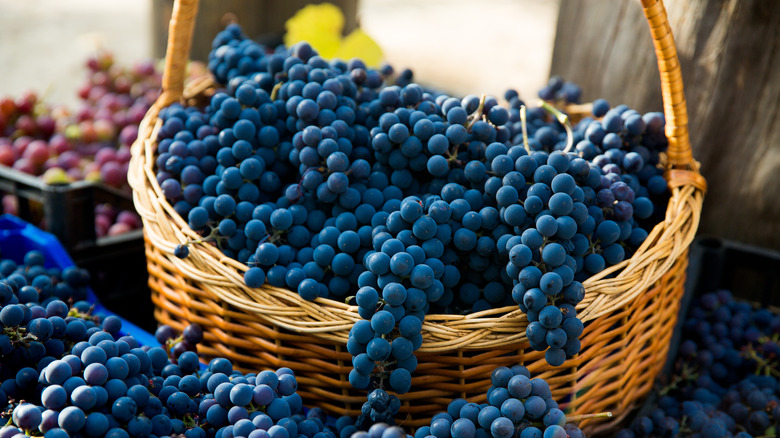Are Round Wines No Longer A Thing?
You may have noticed that the wine world has its own language, whether you simply enjoy a glass of vino or are seriously into wine-tasting. It's hard enough to understand some of the flavor notes, but how do shapes come into play? Some wine lovers may describe a wine as "round," referring to its texture and mouthfeel.
Sommeliers Choice Awards describes a round wine as having a "smooth texture, not coarse or tannic." Tannins are bitter phenolic compounds found in grape skins, stems, and seeds. The proteins bind to the saliva in your mouth, creating a "dry" or astringent sensation (per Wine Enthusiast). With age, the tannins seem less prominent. Some types of wine contain more tannins because the skin remains during part of the wine-making process.
It may help to consider the wines often described as round. "Two wines that are well known for rounded characteristics are Chardonnay and Merlot. If you think of Chardonnay which is oaked and its buttery, creamy characteristics, it's a great example of rounded wine," explains The Cheeky Vino. On the other hand, not every variety of wine benefits from roundness, as they may "lose their character with too much of it," the outlet adds. Some wines that are better off without roundness include Sauvignon Blanc and Pinot Noir. Because roundness denotes texture, it's all about the balance between the tannins and the other characteristics. And if you've noticed that your favorite wines are among the more coarse wines, you're not alone, notes Punch.
The shape of wine
The idea of thinking of tastes and textures as shapes dates back to ancient Greece. Philosopher Democritus imagined bitter and acidic flavors as coming from atoms with jagged edges, while sweeter flavors were smoother, explains Punch. The outlet adds that whether a wine is round or "angular" isn't absolute; it's a spectrum. This spectrum is based on the balance among "acidity, tannin, alcohol, and sugar," explains The Cheeky Vino. they "either work together or against one another to create the texture." And each impacts the mouthfeel. For example, alcohol has a greater viscosity, so wine with a higher alcohol content will feel thicker, per the outlet.
Many enjoy a little edge to their wine. As Punch notes, wine that's too round tends to lose some of the key characteristics people expect from the variety. Toronto-based sommelier Beverly Crandon told Punch, "If I'm using 'round' as a descriptor, I'm talking about a wine where nothing is out of balance. Nothing jumps out at you on the palate." If you enjoy a little bitterness, crisp acidity, or bite to your wine, you may prefer slightly more angular wine.
Now that you can describe the shape of wine, you can explore another important shape in the wine world. The distinctive shape of a wine glass helps highlight the wine's aroma, explains Lucaris Crystal.
Are bright wines on trend?
When considering the trend toward wines that feel less "round," consider the fact that some of the other terms used include "flabby" and "fat," especially if the drinker perceives a wine as "too round." Often, this refers to wine with low acidity and lacking "structure," per Wine Enthusiast. "I compare it to cooking, when you are missing that one ingredient, like citrus, that brings the dish together," Etinosa Empokae, a Philadelphia-based sommelier, told Wine Enthusiast.
That comparison may help clarify why wine with more acidity or tannins may be in fashion. Food ingredients that add acidity include lemon, citrus, vinegar, tomatoes, and wine, per America's Test Kitchen. Foods flavored with these ingredients are often described as bright or tangy, notes Food & Wine. Similarly, wines with higher tannins and acidity may seem "bright" and less rounded. "If you prefer a wine that is more rich and round, you enjoy slightly less acidity," writes Madeline Puckette of Wine Folly.
Drizzly reports that top-selling wine varieties include Prosecco, Cabernet Sauvignon, Sauvignon Blanc, Rosé, Champagne, a red blend, and Pinot Noir. While the roundness varies by the batch, most of these styles of wines are not typically described as round. It isn't an absolute, though — even if you prefer astringent wines, you may also enjoy a buttery, round wine. Think of it like when you go out and enjoy apps with friends. Pickle plates may be popular, but you also enjoy creamy risotto balls.


